April 14, 2019 at 1:02 pm
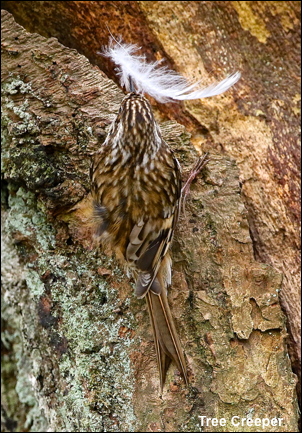 Without the white feather this weeks Tree Creeper is superbly camouflaged against the background tree and would be very hard to spot. Like the Long Tailed Tits of last week Tree Creepers like white feathers to line their nests with. Unfortunately Tree Creepers nests are much more difficult to find than Long Tailed Tits nests. I was fortunate last week to find one and spent a good hour in their company as they came back and forth with any feathers that they could find, especially white ones. Click here
Without the white feather this weeks Tree Creeper is superbly camouflaged against the background tree and would be very hard to spot. Like the Long Tailed Tits of last week Tree Creepers like white feathers to line their nests with. Unfortunately Tree Creepers nests are much more difficult to find than Long Tailed Tits nests. I was fortunate last week to find one and spent a good hour in their company as they came back and forth with any feathers that they could find, especially white ones. Click here
March 31, 2019 at 7:08 pm
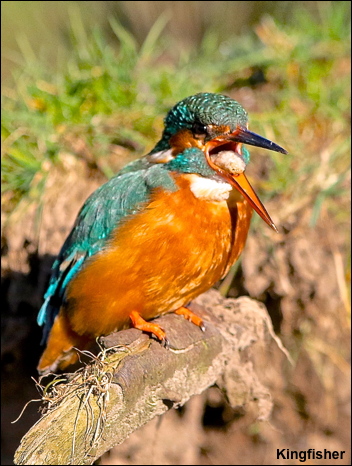 Late February’s superb weather encouraged Kingfishers back to their nest-sites and thoughts turned to the breeding season ahead. I spent a glorious ten hours watching a pair that included the bird in this weeks photo. Suddenly she appeared to be choking which, having witnessed this before, I knew was the start of her regurgitating a pellet of fish bones. Like Owls Kingfishers swallow their prey whole and at a later time the bones, in the form of a pellet, are coughed up and discarded. The sequence of this action is included in this weeks gallery photos.Click here
Late February’s superb weather encouraged Kingfishers back to their nest-sites and thoughts turned to the breeding season ahead. I spent a glorious ten hours watching a pair that included the bird in this weeks photo. Suddenly she appeared to be choking which, having witnessed this before, I knew was the start of her regurgitating a pellet of fish bones. Like Owls Kingfishers swallow their prey whole and at a later time the bones, in the form of a pellet, are coughed up and discarded. The sequence of this action is included in this weeks gallery photos.Click here
This is a great time of year to be involved in wildlife with the overlap in the seasons. One day this week I went from a Chiff-Chaff singing in the garden to Long Eared Owls, Woodcock and Jack Snipe in the hills. The following day I encountered fourteen Peacock butterflies enjoying the sun!
March 24, 2019 at 8:58 pm
While up in North East Scotland last week we paid a quick visit to the Moray Firth hoping to film Long Tailed Ducks. None came within reach of the camera but the rugged coastline did provide good views of Turnstone and Purple Sandpipers battling the wild surf. The Caledonian forests around Loch Garten provided good views of Siskins and the illusive Crested Tits that had already paired off and were busy excavating nest holes. The bird of the short break had to be the Brambling with one field at Boat of Garten having a feeding flock of 200 which never came close to the camera ! The Waxwings that had spent all winter in the area had already left for Scandinavia three days before we arrived !! You can’t win them all! Click here
March 16, 2019 at 6:31 pm
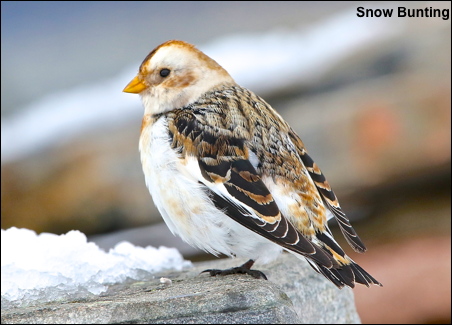 If there is one bird that typifies the high Arctic it is the Snow Bunting. It is a rare breeding bird in Britain and generally only occurs at an altitude of four thousand feet, where the climate is similar to the high Arctic!!
If there is one bird that typifies the high Arctic it is the Snow Bunting. It is a rare breeding bird in Britain and generally only occurs at an altitude of four thousand feet, where the climate is similar to the high Arctic!!
Having filmed them in Greenland, Alaska and Spitsbergen I tend to associate them with snow and last week in the Cairngorms there was lots of snow!
A magical two hours was spent in the car park on Cairngorm in the company of at least fifteen Snow Buntings. A pair came to within two feet of the car as they searched for food after a raging overnight blizzard. Better still was when four or five males began to sing and court the females – it was like being taken to the high Arctic once again but without the expense!! Click here
 Without the white feather this weeks Tree Creeper is superbly camouflaged against the background tree and would be very hard to spot. Like the Long Tailed Tits of last week Tree Creepers like white feathers to line their nests with. Unfortunately Tree Creepers nests are much more difficult to find than Long Tailed Tits nests. I was fortunate last week to find one and spent a good hour in their company as they came back and forth with any feathers that they could find, especially white ones. Click here
Without the white feather this weeks Tree Creeper is superbly camouflaged against the background tree and would be very hard to spot. Like the Long Tailed Tits of last week Tree Creepers like white feathers to line their nests with. Unfortunately Tree Creepers nests are much more difficult to find than Long Tailed Tits nests. I was fortunate last week to find one and spent a good hour in their company as they came back and forth with any feathers that they could find, especially white ones. Click here

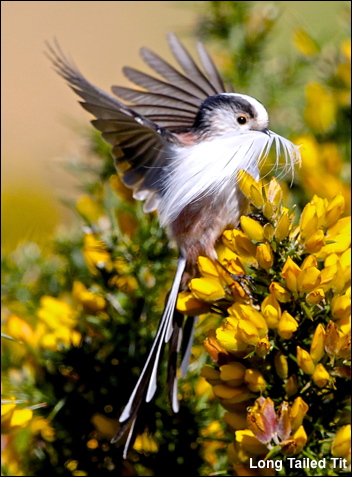 One of the most delightful events in March is filming Long Tailed Tits as they bring in feathers to line their nests. In many years I start my breeding season off with this activity and this year I have been spoilt for choice having found ten nests that were all ready for lining. They are wonderfully tame subjects and with some pairs you don’t even need to be covered up to obtain your photos although generally I like to be under a camouflage cloth. White feathers are their preferred choice but in this weeks gallery you will see one bird bringing to the nest a feather from a Snipe.
One of the most delightful events in March is filming Long Tailed Tits as they bring in feathers to line their nests. In many years I start my breeding season off with this activity and this year I have been spoilt for choice having found ten nests that were all ready for lining. They are wonderfully tame subjects and with some pairs you don’t even need to be covered up to obtain your photos although generally I like to be under a camouflage cloth. White feathers are their preferred choice but in this weeks gallery you will see one bird bringing to the nest a feather from a Snipe.  Late February’s superb weather encouraged Kingfishers back to their nest-sites and thoughts turned to the breeding season ahead. I spent a glorious ten hours watching a pair that included the bird in this weeks photo. Suddenly she appeared to be choking which, having witnessed this before, I knew was the start of her regurgitating a pellet of fish bones. Like Owls Kingfishers swallow their prey whole and at a later time the bones, in the form of a pellet, are coughed up and discarded. The sequence of this action is included in this weeks gallery photos.
Late February’s superb weather encouraged Kingfishers back to their nest-sites and thoughts turned to the breeding season ahead. I spent a glorious ten hours watching a pair that included the bird in this weeks photo. Suddenly she appeared to be choking which, having witnessed this before, I knew was the start of her regurgitating a pellet of fish bones. Like Owls Kingfishers swallow their prey whole and at a later time the bones, in the form of a pellet, are coughed up and discarded. The sequence of this action is included in this weeks gallery photos.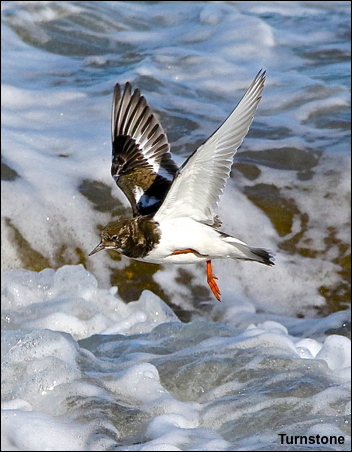
 If there is one bird that typifies the high Arctic it is the Snow Bunting. It is a rare breeding bird in Britain and generally only occurs at an altitude of four thousand feet, where the climate is similar to the high Arctic!!
If there is one bird that typifies the high Arctic it is the Snow Bunting. It is a rare breeding bird in Britain and generally only occurs at an altitude of four thousand feet, where the climate is similar to the high Arctic!!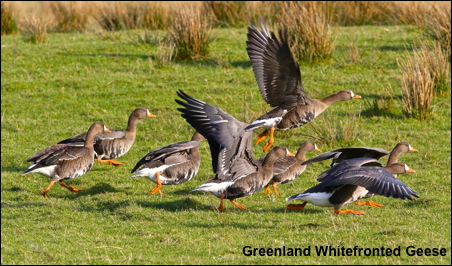 Everyone enjoyed that fabulous warm, summer last year but, unfortunately, it came at a price for Islays Barnacle Geese in Greenland. While we had the good weather all the Atlantic weather fronts that we usually have ended up on the east side of Greenland. As they were so far north, it was still very cold, they produced many feet of snow that ultimately covered the ground all summer. The result was that all our waders like Sanderling and Knot were unable to breed and this extended to Islay’s Barnacle Geese who all breed along Greenland’s east coast. When they returned to Islay in October they brought with them only one young per one hundred adults – the worst breeding season ever recorded.
Everyone enjoyed that fabulous warm, summer last year but, unfortunately, it came at a price for Islays Barnacle Geese in Greenland. While we had the good weather all the Atlantic weather fronts that we usually have ended up on the east side of Greenland. As they were so far north, it was still very cold, they produced many feet of snow that ultimately covered the ground all summer. The result was that all our waders like Sanderling and Knot were unable to breed and this extended to Islay’s Barnacle Geese who all breed along Greenland’s east coast. When they returned to Islay in October they brought with them only one young per one hundred adults – the worst breeding season ever recorded.